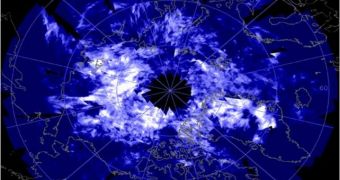The NASA Aeronomy of Ice in the Mesosphere (AIM) satellite was designed specifically to identify and analyze features known as “glow-in-the-dark” clouds, which form high above the surface of the planet, and remain luminous even after nightfall. The structures are also known as noctilucent clouds or Polar Mesospheric Clouds (PMC), and they appear in both the Northern and Southern hemispheres, during their respective summer seasons. AIM managed to survey these structures for five complete seasons, and now provides experts with the first full map of their development, Space reports.
The clouds form some 50 miles (80 kilometers) above Earth's surface. In the northern hemisphere, they can be seen predominately from late May to late August, while the southern skies reveal them from late November to late February. The AIM investigation has revealed that the clouds form at very high speeds, but also that they disperse just as fast. The satellite's instruments have also determined that they atmospheric structures are also highly dependent on weather systems for their formation, NASA experts announce.
“The AIM findings have altered our previous understanding of why PMC form and vary. We have captured the brightest clouds ever observed and they display large variations in size and structure signifying a great sensitivity to the environment in which the clouds form,” says Hampton University in Virginia expert James Russell III, who is also the principal investigator of the AIM mission. “The cloud season abruptly turns on and off going from no clouds to near complete coverage in a matter of days with the reverse pattern occurring at the season end,” he adds.
The clouds form at temperatures of minus 210 to minus 235 degrees Fahrenheit (minus 134 to minus 148 degrees Celsius), in the higher layers of the atmosphere. Experts believe that the main formation mechanisms imply water vapors condensing over airborne dust particles, and then creating ice crystals which reflect light. The reason why noctilucent clouds remain visible from the ground after sunset is the fact that they are at very high altitudes. This allows them to be illuminated by the Sun for a longer period of time, until the star finally moves far away, on the other side of the planet, where the curb of the horizon does not allow for its rays to hit the ice crystals in the sky.

 14 DAY TRIAL //
14 DAY TRIAL //